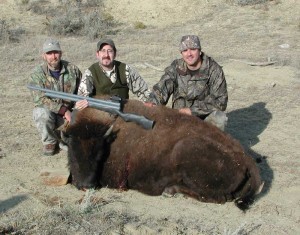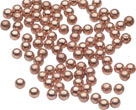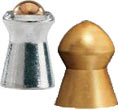Remember those early days? A one pump max and no eye protection. Of course that all goes out the winder after you take a shot to the small of your back and you start putting fifteen pumps on a tem pump max pellet gun. About that time dad usually walks out and asks what the hell is going on. Or the other days spent taking down nuisance animals around the home and yard…at least until dad walks out and asks what the hell you’re doing.
When I was young an air gun meant plastic pellets, zinc BBs, or steel pellets for taking down pigeons. I never realized they chambered air guns for up to .45, .357, or even .50 cal. Apparently these have been used to take down animals as large as deer and wild pigs; and come in rifle and pistol platforms. Some feature speeds as high as 1,100 fps.
As a side note, that picture was from Bigbore Airgun Adventures.
I had no idea they made large bore air guns, and was surprised to hear them brought up on Gun Talk via the radio last night. With my interest peeked I had to do a little research and here are some of the interesting things I stumbled on.
While the single shot feature of most of these rifles and pistols make them less than favorable for actual home defense or combat style operations, they are worth sharing as the sport continues to gain popularity. Advantages are that they are not a controlled and registered item like actual firearms. There is some confusion over federal law in regards to air gun supressors, whether mountable or as a permanent integral part of the weapon system. From Silencers on Airguns? On beemans.net : “The BATF has ducked the airgun silencer issue by continuing to say that they have no jurisdiction over airguns – BUT they leave the matter open by pointing out that an airgun silencer that could be used on a firearm, even if it was necessary to destroy an integrated airgun to get it, is, by federal definition, A FIREARM…”
From Top Air Gun: “If you like to hunt or have a pest problem a gun is one of the best most effective tools you can use to take down small and large game. However, traditional guns are loud and illegal to shoot in most areas. If you use a gun for pest control and live in a fairly urban area it can be disturbing to neighbors and is most likely against the law. The best high powered airguns designed specifically for pest control and hunting provide the power you need to take down game of all sizes, are quiet and legal to shoot in most places.
When purchasing a high powered pellet gun for hunting it is important to make sure it is powerful enough for taking down game and pests. Not all airguns are created equal and not all pellet guns are made for hunting. Cheap low quality toy bb guns and can killing pellet guns do not have the power or accuracy required for hunting and pest control. It is also important to make sure the airgun you buy is powerful enough to take down the size of animal you are going to be hunting. No matter what size animals you are going to be hunting large, medium or small there is a high powered pellet gun perfect for your hunting needs.”
I’d like to leave you with a great little article form the Cabela’s website, Air rifle Buyer’s Guide by Mike Schoby and Matt Smith:
Like most Americans, your first “gun” was probably an air rifle. Mine was. It came the Christmas of my seventh year, the box wrapped in brown paper, poking conspicuously out from under the tree. I recall ignoring all the other presents and literally rushing at that box, praying that it was not a dirty trick; socks stacked end to end, or a shovel or something equally disappointing. As I hoped, it was a BB gun – a Daisy Red Ryder, to be exact, just like I had asked for – the quintessential BB gun for literally millions of American youths.
While Daisy Red Ryders are still around, and are still one of the most popular “starter” BB guns today, there are now more models of air rifles than ever before to choose from. Whether you are looking to get a youth started in the fine sport of shooting, or a fun plinker for yourself, here is what you need to know about air rifles before spending your hard-earned cash.
Different Propulsion Methods
Air rifles can be broken into three main categories depending upon the powerplant they employ to launch a projectile downrange: CO2, Pneumatic and Spring Piston.
CO2 Powered
CO2 powered air rifles come in many different shapes and sizes, but one thing they all have in common is that CO2 canisters power them all – the most common being the small, 12-gram cartridge (however there are other sizes). The main advantages of CO2 powered guns are that they are easy to use, guns can be crafted in almost any shape/size with few limitations, and no pumping is required. However, CO2 does have its disadvantages. CO2 powered guns are limited in power and are more expensive to shoot on a per shot basis due to the cost of the CO2 canisters. However, the biggest disadvantage for the outdoor shooter/hunter is the fluctuation of CO2 pressure in relation to ambient air temperature. At room temperature, a CO2 canister roughly produces between 900-1000psi, but as the temperature increases or decreases so does the pressure – this change in pressure results in vertical stringing of shots and marginal shot-to-shot accuracy.
Pneumatic
Pneumatic air rifles essentially are any type of air rifle that uses compressed air to propel a pellet. There are two main types of pneumatics: pump-up and pre-charged.
The pump-up varieties are the type most American shooters are familiar with. Pump-up air rifles compress air with a built-in pumping lever, generally located in or around the forearm section of the gun. Pump-up guns are moderately powerful (and the power can be adjusted by the amount of pumps per shot), and have the advantage of not using costly CO2 cartridges to propel a pellet. The big disadvantage of the pump-up gun is the time and effort needed to charge the gun for each shot. From a small-game hunting standpoint, the noise and movement is a major drawback.
Pre-Charged Pneumatics
Pre-charged pneumatics are interesting guns – generally operating similar to pump-up pneumatics, without the hassle of pumping them up after every shot. Pre-charged pneumatics use a large air reservoir of highly pressurized air (up to 3,000 psi), which results in dozens of shots before needing to be recharged. Recharging is a simple matter, either with a high-pressure hand pump or a SCUBA tank. These guns have many advantages; they can be extremely powerful (the most powerful air guns made are pre-charged pneumatics), are often very accurate and most are made of high-quality parts and craftsmanship. The only real downside to most pre-charged air guns is the cost of the gun itself and the initial investment in either a pump or SCUBA tank.
Spring Piston
Spring piston airguns are probably the most common “adult level” air guns. They utilize a stout spring and air piston to propel a pellet down range. The operation is actually very simple; for each shot the spring is retracted (by various means discussed later), and when fired, the spring pushes the piston forward, propelling a charge of air into the barrel. These types of air rifles are very consistent on a shot-to-shot basis, can be extremely accurate and are often very powerful. While the spring piston is the propulsion method, there are several types of cocking mechanisms, such as barrel-cocking, side-cocking and underlever. All methods essentially do the same job, with a different placement of the lever, however, it should be noted that certain designs such as side-cocking and underlevers are slightly more accurate than barrel-cocking models due to their longer sight plane and stiffer barrel-to-action mating, but for hunting and general plinking the advantage is not significant enough to make much of a difference.
Air Rifle Calibers
Over the years, air rifles have been produced in literally dozens of calibers, and while there are manufacturers that still produce custom calibers for specific purposes, the vast majority of air rifles manufactured today come in one of four common calibers: .177, .20, .22, .25.
By far the most common of these four is the .177 caliber. This caliber is the same diameter as a steel BB and many guns chambered in .177 can fire either BBs or pellets (however be sure to read your particular guns owner’s manual as some only shoot one or the other, but not both). The .177 is an excellent target caliber and also serves well for shooters interested in cost effective plinking and some pest control such as rats and sparrows. The .177 caliber also boasts high velocities, good penetration and a flat trajectory.
The next most common caliber is the .22. The .22 is primarily used for small-game hunting and is an efficient caliber for delivering energy downrange due to its heavier pellets, however due to lower velocities it is not as flat shooting as the speedier .177.
The .20 caliber is probably the third most common air rifle caliber. While it is not as popular as either the .177 or the .22, it is an effective caliber in its own right. Most .20 caliber air rifles have high velocities, flat trajectories and enough downrange energy to make them a highly effective small-game hunting tool. Many proponents of the .20 feel it is the perfect air gun caliber; gleaning the best characteristics (velocity combined with energy) of both the .177 and .22.
The least known of the four common air rifle calibers is probably the .25. It is only chambered in a few rifles and lacks much of a following in the U.S. However, it is a substantial small-game hunting caliber and carries a lot of energy downrange for quick, humane kills. Since the velocity is slower than all of the aforementioned calibers, it has a more “rainbow-like” trajectory, but within reasonable ranges, it is considered the best caliber for the dedicated small-game hunter.
Different Types of Pellets
Traditionally, air rifles fired steel BBs and while many still do, today most use lead pellets instead. Pellets are safer (less ricochet hazard), more accurate and carry more energy (which is good from a hunting standpoint). Initially, pellets were designed with a flat nose, and were primarily used for paper targets and short-range small-game hunting. But with the advancement of technology and airflow analysis, several types are now available.
Wad cutters – Characterized by their flat nose, these pellets are typically associated with target shooting due to their accurate nature and clean hole-cutting properties in paper, but also serve well for close range, small-game hunting as they transfer lots of energy to the target.
Round nose – These pellets are good all-around pellets for plinking, target shooting and small-game hunting.
Pointed pellets – Pointed pellets are generally used for hunting where maximum penetration is desired.
Hollow point – Hollow-point pellets are also used for hunting, and shine where maximum transfer of energy is required.
Gamo Performance Ballistic Alloy (PBA) pellets – A faster, lighter ammo choice. Accuracy is “match grade.” However, PBA pellets are 50% harder than lead pellets and speed is increased by as much as 25%.
Polymer tip hollow-head pellets – Called “the best pellet for hunting,” this pellet has a hard, polymer ballistic tip that cuts the air cleanly for exceptional accuracy. Upon impact, the polymer tip causes the pellet expand outward. This increases the diameter of the projectile as it passes through the intended target.
Crosman Powershot pellets – In addition to being the newest design on the market and more environmentally friendly by being lead-free, the belted, pointed Powershot pellets is designed to maintain shape after impact, providing better penetration for hunters.
Uses of Air Guns:
Hunting with air-powered rifles is nothing new; in fact it is one of the oldest of all hunting methods, dating well back into the 16th century. Over the years, air guns have been built in many large calibers (.50 and above) and have taken game up to and including elk-sized animals. However, for the vast majority of air gun hunters today, small game is the main quarry.
Modern air guns can be used for a variety of small-game hunting and pest control. For animals such as rats, squirrels, and crows, most high-powered rifles that produce roughly 1,000 fps in .177, .20 or .22 will be more than sufficient. For small-game hunting up to and including raccoon-sized game, consider magnum powered .20, .22 and .25 calibers a more suitable choice. Like all hunting, if the effective range of the firearm is heeded (in the case of most air rifles this is under 30 yards), and shots are placed properly, humane kills are the result.
Formal target shooting and competitions have been popular in other countries for years, but only in the last couple of decades have they really gained momentum in the U.S. There are many different target-shooting disciplines from running boar to three-position and competitions are held each year at the local, state and national level. Airgun competitions are also an official Olympic event for both men and women. In this sport, dedicated .177 target air rifles reign supreme, but to get started, almost any high-quality .177 side-cocking spring piston air rifle will work for a beginner.
Many big-game hunters have found tremendous benefit from practicing in the off season with an air rifle. It is cheap, noise free (which helps overcome flinching), recoilless and can be done in the backyard or even inside with the proper backstop. By practicing field shooting positions several times a week – you will see a marked improvement in your shooting skills when afield after big game.
It is easy to see that air guns are not simply “kids toys” anymore. They span the gamut from inexpensive starter guns to works of art and scientific precision costing thousands of dollars. But by understanding how the different models operate, paired with your intended purposes, you will be sure to find a model that not only fits your needs, but also your budget.”
Jon










Where can I find info on the larger air gun calibers such as .45 caliber and .357 caliber that you mentioned but failed to include in your comments?? Here in Louisiana the Texas feral hogs come for a visit. I’d like some to end up in my freezer.
I listen to these guys every Sunday where I live and they had a great discussion on the topic recently (http://www.guntalk.com/site.php). I would highly recommend giving them a shout out; their knowledge is phenomenal and you can call or email.